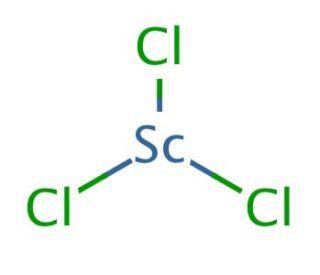CHEMICAL SUBSTANCE DATASHEET
|
CHEMICAL SUBSTANCE IDENTIFICATION |
|
|
Chemical name |
Scandium chloride |
|
Synonyms |
Scandium trichloride; Scandium(III) chloride; Scandium chloride (ScCl3); Scandium(3+) chloride; Scandium(III) chloride, anhydrous [2] |
|
IUPAC name |
trichloroscandium [2] |
|
CAS No |
10361-84-9 |
|
REACH registration number |
on EC list ( REACH pre-registration) |
|
EC No |
233-799-1 |
|
Molecular formula |
Cl3Sc |
|
Substance group/chemical family |
inorganic, ionic compound [3] |
|
Appearance Physical state Odour Form Colour |
deliquescent solid [8] odourless [8] powder white to slightly beige [1, 8] |
|
USES AND HANDLING ISSUES |
|
|
Relevant identified uses |
Scandium(III) chloride is found in some halide lamps, optical fibers, electronic ceramics, and lasers. [3] |
|
Handling considerations |
Wear suitable gloves and eye/face protection. Handling: Minimize dust generation and accumulation. Avoid breathing dust, mist, or vapor. Avoid contact with eyes, skin, and clothing. Keep container tightly closed. Avoid ingestion and inhalation. Use with adequate ventilation. Wash clothing before reuse. |
|
PHYSICO-CHEMICAL PROPERTIES |
|
|
Molecular weight |
151.31 g/mol [1, 2] |
|
Bulk density/Specific gravity |
2.39 g/mL at 25 °C [1] |
|
pH |
|
|
Particle size |
|
|
EC |
|
|
Melting point |
960 °C [1] 63 °C (hexahydrate) [3] |
|
Boiling point |
962.79°C (estimate) [1] |
|
Flash point |
|
|
Flammability |
|
|
Vapour density |
|
|
Vapour pressure |
|
|
Solubility in water |
soluble in water [1] |
|
Solubility in organic solvents |
insoluble in alcohol [1] |
|
Solubility in inorganic solvents |
|
|
Hydrolysis |
|
|
Ionicity in water |
|
|
Surface tension |
|
|
Dispersion properties |
|
|
Specific surface |
|
|
Stability and reactivity |
|
|
Chemical stability |
Stable at room temperature in closed containers under normal storage and handling conditions. [4] |
|
Reactivity hazards |
Hazardous Decomposition Products: Hydrogen chloride [4] |
|
Corrosivity |
|
|
Polimerization |
Will not occur [4] |
|
Incompatibility with various substances |
|
|
Special remarks on reactivity |
Hygroscopic [1] Avoid moisture, excess heat, exposure to moist air or water. [4] |
|
Physical, chemical and biological coefficient |
|
|
Koc |
|
|
Kow |
|
|
pKa |
|
|
log Kp |
1.16 (predicted average) [6] |
|
Henry-constant |
|
|
ENVIRONMENTAL FATE AND BEHAVIOUR |
|
|
Artificial pollution sources |
|
|
General terrestrial fate |
|
|
General aquatic fate |
|
|
General atmospheric fate |
|
|
General persistence and degradability |
|
|
Abiotic degradation and metabolites |
|
|
Biodegradation and metabolites |
|
|
Bioconcentration |
|
|
Volatilization |
|
|
Photolysis |
|
|
Hydrolysis |
|
|
Soil adsorption and mobility |
|
|
ENVIRONMENTAL CONCENTRATIONS |
|
|
Measured data |
|
|
|
|
|
ECOTOXICOLOGICAL INFORMATION |
|
|
General adverse effects on ecosystem |
|
|
Acute toxicity (LC50, EC50) |
|
|
Aquatic systems |
|
|
Terrestrial systems |
|
|
Chronic toxicity (NOEC, LOEC) |
|
|
Aquatic systems |
|
|
Terrestrial systems |
|
|
HUMAN HEALTH EFFECTS and PROTECTION |
|
|
Routes of human exposures |
|
|
General effects |
Fibrogenic [8] |
|
Endocrine disruption |
Data lacking [5] |
|
Mutagenicity |
Data lacking [5] |
|
Carcinogenicity |
Data lacking [5] |
|
Reprotoxicity |
Data lacking [5] |
|
Teratogenicity |
Data lacking [5] |
|
Skin, eye and respiratory irritations |
Data lacking [5], Fibrogenic [8] |
|
Metabolism: absorption, distribution & excretion |
Data lacking [5] |
|
Exposure limits |
|
|
Drinking water MAC |
|
|
Other information |
May be harmful if swallowed [1], Fibrogenic [8] |
|
Animal toxicity data |
|
|
Acute toxicity (LD50) |
3980 mg/kg (mouse, oral), 93.358mg/kg (mouse, intraperitoneal) [9] |
|
Chronic toxicity (NOEL, LOEL) |
|
|
ENVIRONMENTAL STANDARDS AND REGULATIONS |
|
|
EINECS regulation |
̵ |
|
OSHA regulations etc. |
None of the chemicals in this product are considered highly hazardous by OSHA. [4] |
|
|
|
|
OTHER INFORMATION, SPECIAL REMARKS |
|
|
Classification and proposed labelling with regard to toxicological data |
H319 Causes serious eye irritation. [5] |
|
|
|
|
CREATED, LAST UPDATE |
|
|
Created |
2018. 10. 29. |
|
Last update |
2018. 10. 30. |
|
REFERENCES |
|
|
[1]Chemical book, CAS DataBase List https://www.chemicalbook.com/ChemicalProductProperty_EN_CB1493713.htm https://www.chemicalbook.com/CASEN_10361-84-9.htm, Accessed 30th October, 2018. [2] PubChem, National Center for Biotechnology Information, Compound Summary, Scandium Trichloride https://pubchem.ncbi.nlm.nih.gov/compound/Scandium_trichloride#section=3D-Status, Accessed 30th October, 2018. [3] Wikipedia, https://en.wikipedia.org/wiki/Scandium_chloride, Accessed 30th October, 2018. [4] Material Safety Data Sheet, Scandium trichloride, anhydrous, 99.99% https://fscimage.fishersci.com/msds/98752.htm, Accessed 30th October, 2018. [5] European Chemicals Agency (ECHA) https://echa.europa.eu/substance-information/-/substanceinfo/100.030.714 , https://echa.europa.eu/information-on-chemicals/cl-inventory-database/-/discli/notification-details/81096/1355273, Accessed 30th October, 2018. [6] EPA DSStox data, Scandium(III) chloride https://comptox.epa.gov/dashboard/dsstoxdb/results?search=DTXSID5042372#properties, Accessed 30th October, 2018. [8] NIH, US National Library of Medicine, HAZMAP, Scandium Cloride https://hazmap.nlm.nih.gov/category-details?id=8689&table=copytblagents, Accessed 30th October, 2018. [9] NIH, TOXNET, Chem ID plus, Substance, Scandium chloride, https://chem.nlm.nih.gov/chemidplus/rn/10361-84-9, Accessed 30th October, 2018. |
|
